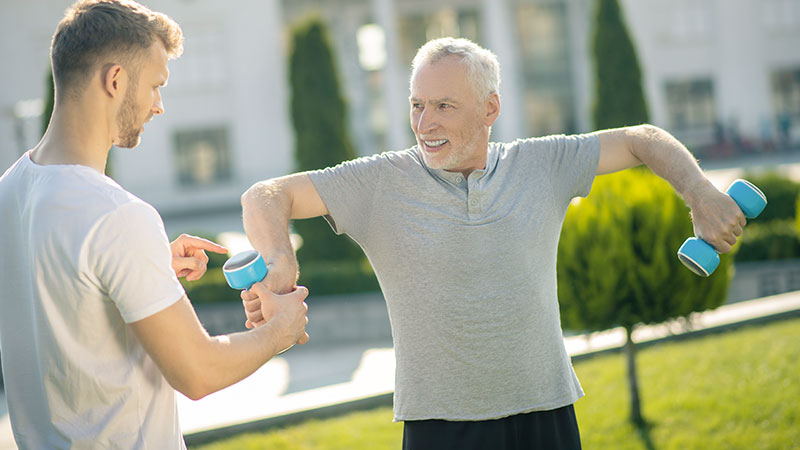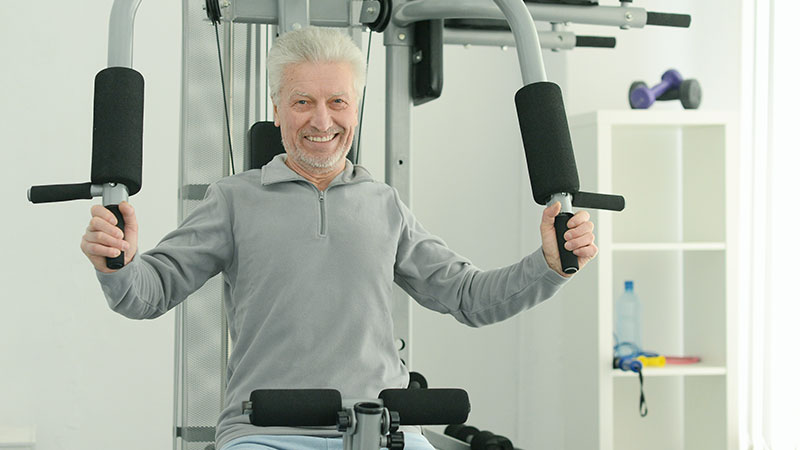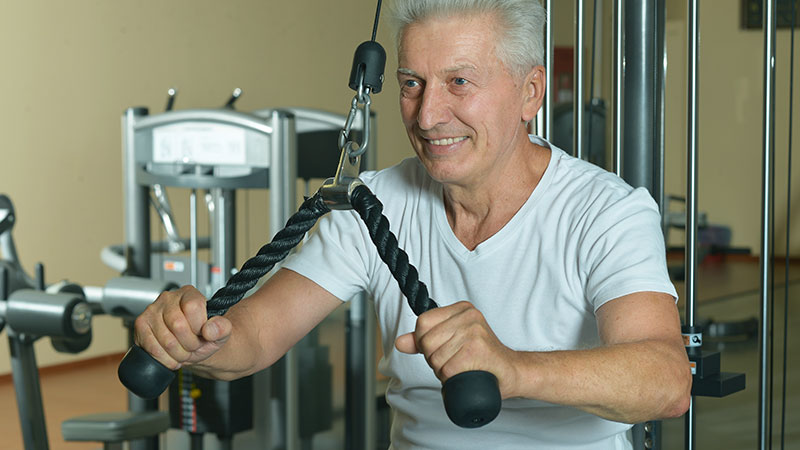As we age, our health priorities shift, making regular exercise more crucial than ever. Whether it’s resistance training, cardio, yoga, Pilates, or Tai Chi, incorporating these activities into your routine can significantly enhance your physical health, mental wellbeing, and overall quality of life.
But what exactly makes exercise so beneficial for seniors? Beyond the obvious physical health improvements, it plays a pivotal role in managing numerous health issues, improving mobility, and maximizing life quality.
Fitness programs aren’t just about hitting specific milestones, they’re about catering to your specific health and wellness needs.
So, let’s delve into the world of fitness for seniors, exploring the best exercises for older adults, and how to kickstart your journey towards a healthier, more active lifestyle. Stay tuned as we unravel the power of exercise for seniors, one health benefit at a time.

Physical Benefits of Exercise for Seniors
As you seek to stay fit and healthy in your golden years, exercise becomes increasingly vital. Here are some of the physical benefits seniors can reap from routine workouts.
Disease Prevention
Regular exercise enhances activity and aids in preventing diseases like heart disease and diabetes.
Heart rate increasing activities such as aerobic exercises and muscle-strengthening routines lower the risk of chronic conditions.
Additionally, physical activity promotes healthy cholesterol levels and improved blood circulation. Hence, regular workouts are crucial not only for fitness but also for illness prevention.
Bone Loss Prevention
Exercise is crucial for bone health, particularly as we age and natural bone loss occurs. Weight-bearing exercises like walking, running, and resistance training help promote calcium absorption in bones thereby reducing the risk of osteoporosis.
For those at high risk for this disease, using exercise equipment designed to increase bone density may be beneficial. An active lifestyle aids in maintaining healthy bone density.
Fall Prevention
With age, falls can become a concern—but consistent exercise can be an effective countermeasure. By undertaking routine workouts that help to increase strength and flexibility, your body becomes better equipped to avoid falls.
Muscle-strengthening routines, for example, can help you maintain balance and coordination, making accidents less likely. So, you’re not just working out, you’re working towards a safer everyday life.
Boosting the Immune System
Regular exercise is also an immunity booster, a benefit that’s particularly essential for seniors since immune systems can often be compromised with aging. Even light exercise, such as walking, can improve overall immune function.
This makes you less susceptible to colds, flu and other illnesses. This way, regular workouts not only keep you physically active, but also healthily fortified against diseases.
Mental Benefits of Fitness for Seniors

Turning the focus more towards the mind, let’s delve into how exercise helps seniors maintain their mental wellness.
Improved Mental Health
Regular exercise is not only beneficial for physical strength and agility, but it’s also vital for mental health.
It helps improve mental wellbeing and serves as a safeguard against non-communicable diseases such as cardiovascular disease, stroke, and diabetes.
Regular fitness can also delay the onset of dementia, highlighting the significant link between physical activity and mental health.
Enhanced Cognitive Function
Exercise impacts both physical health and brain functions such as organization, planning, and focus.
A reciprocal relationship exists between mental abilities and exercise – regular physical activity enhances cognitive function, which then encourages continued exercise.
This connection could be leveraged to help the elderly maintain their overall health and independence for a longer duration.
Social Benefits of Fitness among Seniors

In addition to the physical and mental advantages, the social benefits of fitness shouldn’t be overlooked, especially for seniors. Regular exercise can greatly enrich their social life and overall life quality.
Promoting Social Engagement
Exercise aids in enhancing physical and mental health, as well as promoting social interactions, especially among the elderly.
Regular group fitness activities offer older people a chance to connect with others and form relationships, counteracting feelings of isolation.
These increased social connections can reduce depression and poor health symptoms commonly linked to diminished social engagement due to retirement, loss, or limited mobility.
Improved Quality of Life
Regular exercise improves both physical strength and overall life quality, including self-rated health even in those who have suffered serious health problems like acute myocardial infarction.
It benefits seniors by promoting better physical health and expanding social circles, consequently enhancing their quality of life.
The key lies in identifying the appropriate exercise routine and maintaining a commitment to it, especially in senior years.
How Much Exercise Should Seniors Get?

With all the benefits that physical fitness offers to seniors, it’s natural to wonder just how much exercise is best. The key is to maintain consistency with your workouts and, where necessary, gradually raise the intensity.
Let’s delve further into some of the guidelines.
Understanding the Recommended Exercise Duration
Older adults should aim for about 150 minutes of moderate-intensity exercise per week, spread across most days. However, the frequency and duration can be adjusted to suit individual health and fitness levels.
Along with cardio work, seniors should also focus on strength, balance and flexibility exercises at least two days a week to prevent falls, improve bone health and maintain muscle mass.
Consistency in exercising is key for better health as it’s not just about the length or intensity of workouts.
Safety Measures in Exercising for Seniors

Understanding the need for exercise safety can help seniors avoid injuries and better enjoy the overall benefits of physical activity. Here are some precautions that you should take before and after a workout.
Pre-Exercise Safety Tips
- Consult with Medical Professionals: Before starting any exercise regimen, first, talk to your doctors. This is especially pertinent if you’ve not been physically active for some time or if there are underlying medical considerations.
- Understand Overtraining Signs: Work out frequency can be increased gradually, say, to five days a week, but you should be watchful for signs of overtraining, like an incessant sense of exhaustion, decreased physical performances, or issues with sleep.
- Stick to Public Health Guidelines: Adhere to the American College of Sports Medicine and the Centers for Disease Control and Prevention‘s advice—60 to 75 minutes of vigorous aerobic activity per week, or 150 minutes of moderate aerobic activity, along with two to three strength training sessions.
- Listen to Your Body: Bear in mind that exercise should not induce pain or make you feel lousy. If you experience dizziness, shortness of breath, chest pain or pressure, a cold sweat or any uncontrollable pain during exercise, stop immediately and consult with your doctor.
- Attend to Injuries Promptly: If any part of your body becomes red, swollen, or tender post-exercise, put your routine on hold. The best way to cope with injuries is to avoid them in the first place, but if they do occur, immediate medical attention is a must.
- Regular Pain Assessment: If you regularly experience pain during or following your workout, it’s likely that your body is warning you of potential physical strain or harm. Under such circumstances, it would be wise to adjust your exercise routine or to seek professional advice.
Available Exercise Programs for Seniors

Now that you’re aware of how exercise can enhance your quality of life, it’s time to dive into specific programs tailored for seniors.
These have been carefully designed while considering common health issues and physical constraints that older adults may exhibit.
Importance of Adapted Exercise Programs
Ensure you consider adapted exercise classes designed with senior citizens in mind. These classes typically encompass low-impact and flexibility-enhancing exercises suitable for older bodies. Here are a few recommended programs you can explore:
- Water Aerobics and Water Sports: These workouts provide a low-stress environment for your joints. By utilizing water’s resistance, they can strengthen your muscles, enhance balance, and improve overall endurance.
- Yoga: Yoga is a versatile option that combines controlled breathing with various poses to improve strength, balance, and flexibility. As a considerable advantage, yoga can be adapted to suit any fitness level, reinforcing its suitability for seniors.
- Tai Chi and Qi Gong: Inspired by martial arts, these movement systems can increase balance and strength. The slower pace and emphasis on controlled movement make them especially beneficial for the elderly. Many local community centers and YMCA organizations offer tailored classes for senior citizens.
Remember to seek medical clearance from your doctor first, especially if you have pre-existing conditions.
Advantages of Guided Home Exercise Plans
Some seniors might prefer, or find it necessary to exercise at home. For them, a guided home exercise plan can be an advantageous route.
It offers flexibility in schedule, customizability in routines, and comfort of the familiar environment. Here are some effective home-based exercises:
- Chair Exercises: Great for seniors concerned about falling. These exercises can improve muscle strength, enhance flexibility, and build balance.
- Recumbent Bike Riding: A low-impact cardio exercise that strengthens the lower body and improves heart health, all while sitting down.
- Swimming or Pool Aerobics: For those fortunate enough to have pool access at home, these exercises can provide excellent full-body workouts.
Again, please start slow and build your routine steadily. Grow your fitness and confidence over time while paying attention to any discomfort or pain, which may indicate the need for routine adjustment or medical consultation.
Remember, consistent exercise will not only improve your physical wellbeing but also your cognitive function and overall quality of life in the long run.
Frequently Asked Questions
What are the benefits of regular exercise for seniors?
Regular exercise for seniors brings numerous physical, mental, and social advantages. It aids in disease prevention, improves mental well-being, advances cognitive activities, and enriches social interaction, especially through group fitness.
What are the recommended exercise guidelines for seniors?
Seniors are advised to engage in roughly 150 minutes of moderate-intensity exercise per week. The exact time can be flexible, depending on the person’s overall health. A combination of strength, balance, and flexibility exercises are recommended for optimal health and fall prevention.
What safety measures should seniors take before beginning an exercise program?
Before starting an exercise program, seniors should consult with their healthcare professional. Extra vigilance should be taken to understand the symptoms of overtraining, adhere to public health guidelines, listen to their bodies, treat injuries right away, and adjust any activities causing regular pain.
What types of exercise programs are beneficial for seniors?
Exercise programs that may be beneficial for seniors include water aerobics, yoga, Tai Chi, and Qi Gong. Guided home exercise plans catered to senior citizens can be greatly advantageous as well.
How can seniors maintain momentum in their fitness journey?
To keep motivated and overcome any roadblocks, seniors can set short-term goals, devise a reward system for meeting fitness milestones, and regularly track progress. These strategies can help maintain fitness momentum.
References
After all you’ve read, it’s clear that regular exercise isn’t just for the young. It’s a vital part of aging well and staying healthy. It can help ward off diseases, improve your mental health, and even boost your cognitive function.
Plus, it’s a great way to stay social. Remember, around 150 minutes of moderate exercise each week is the sweet spot. But don’t forget to listen to your body and consult with your doctor to ensure you’re exercising safely.
Whether it’s water aerobics, yoga, Tai Chi, or a guided home exercise plan, there’s a fitness program out there that’s just right for you.
Set those short-term goals, reward yourself for reaching milestones, and track your progress. You’ll find maintaining your fitness momentum as a senior isn’t just doable, it’s enjoyable too!
Conclusion
The text emphasizes the importance of focusing on short-term fitness goals, especially when facing obstacles such as illness or weather changes, as they can bring swift improvements in mood, energy levels and reduced stress.
It suggests creating a reward system for achieving milestones to maintain motivation. Additionally, keeping track of activities, either through writing them down or using an app, can hold individuals accountable and serve as a reminder of progress made.
These strategies help overcome hurdles and contribute to overall fitness goals, promoting a healthier lifestyle.
I am a fitness instructor and I have been in the industry for 9 years. I have a passion for health and fitness.
I am a fitness instructor with over 9 years of experience in the industry. My passion is health and fitness and I would love to share my knowledge with you!